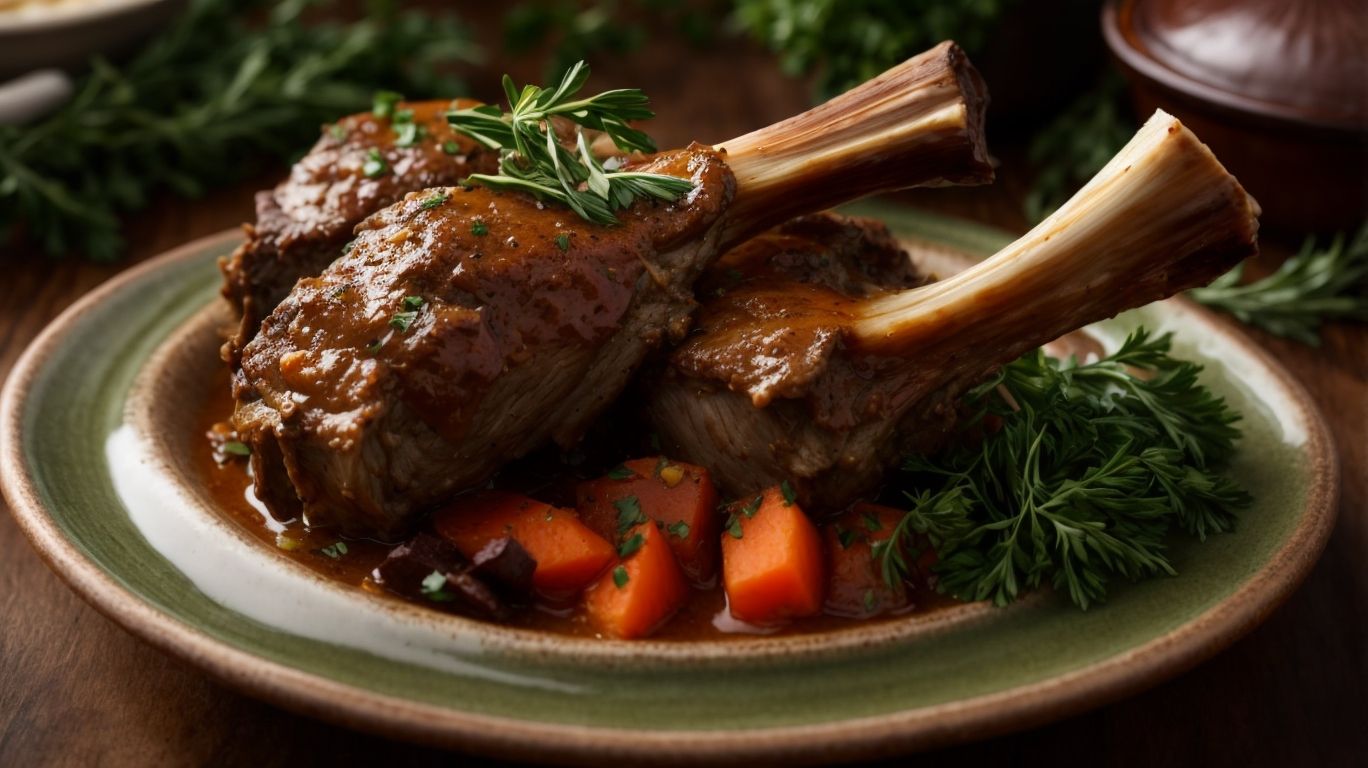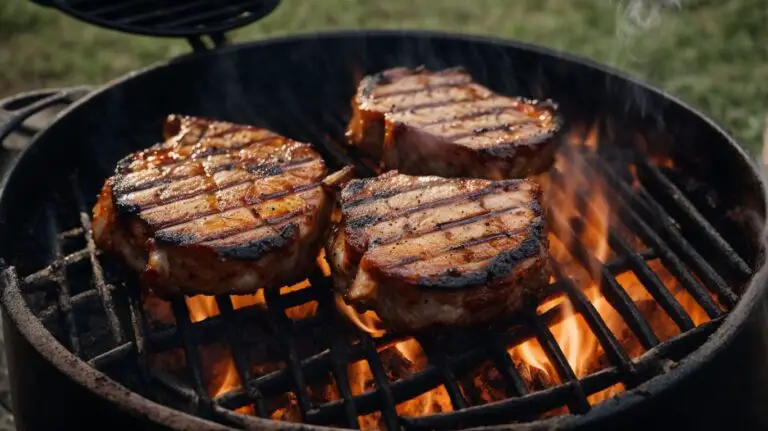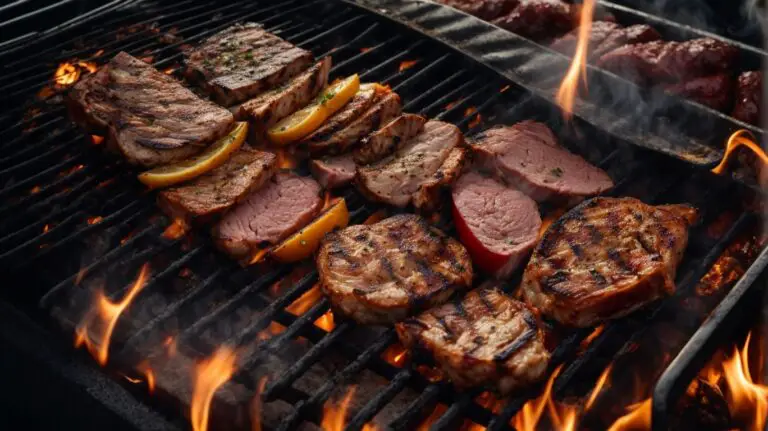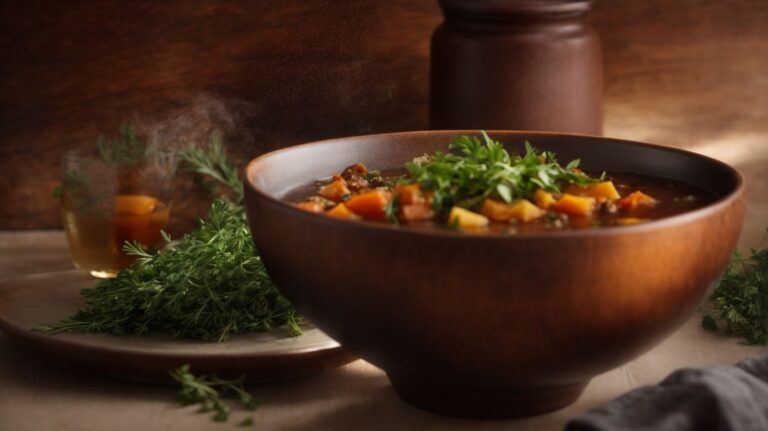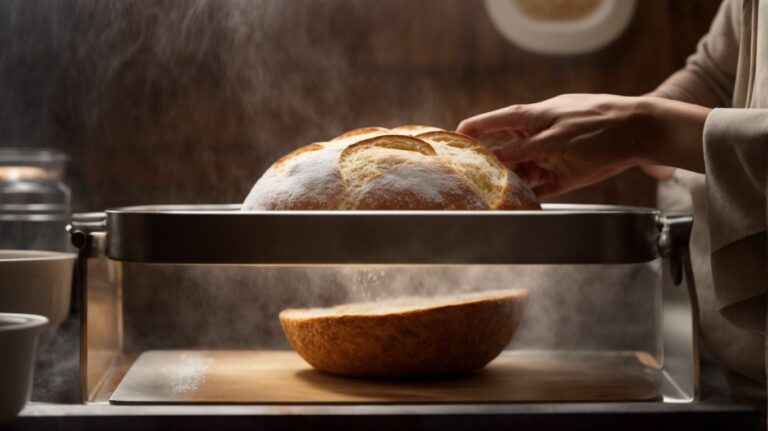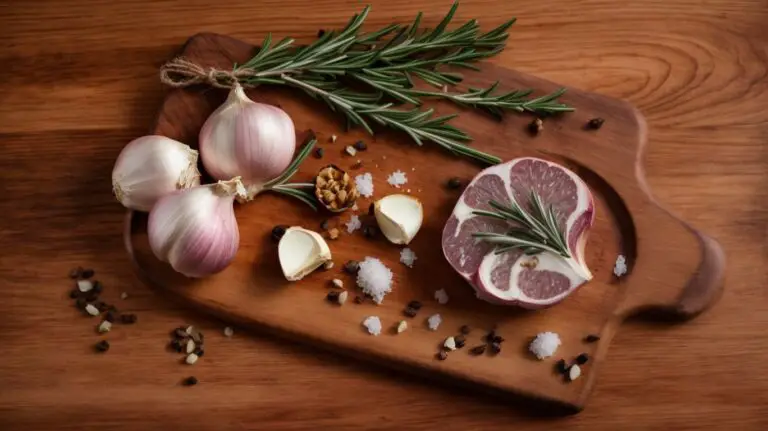How to Cook Lamb Shanks?
Curious about cooking lamb shanks but not sure where to start? Look no further!
In this comprehensive guide, we will cover everything you need to know about preparing, cooking, and enjoying delicious lamb shanks.
From choosing the right cuts to different cooking methods and mouth-watering recipes, we’ve got you covered.
So grab your apron and get ready to elevate your culinary skills with these savory lamb shank dishes!
Key Takeaways:
What Are Lamb Shanks?
Lamb shanks are a flavorful cut of meat that comes from the lower section of the lamb’s leg, known for their tenderness and rich taste.
They are prized for their unique texture, offering a perfect balance of tender meat and succulent connective tissues. The most common cooking method for lamb shanks involves slow-cooking them in a savory braising liquid until the meat is beautifully tender and falls off the bone effortlessly.
This slow cooking process allows the flavors to meld together, creating a dish that is both hearty and full of depth. Lamb shanks are incredibly versatile, lending themselves well to a variety of seasonings and flavor profiles, making them a favorite in cuisines around the world.
What Are the Different Types of Lamb Shanks?
Regarding lamb shanks, there are various types available, including bone-in and boneless shanks, each offering unique advantages when cooking with different braising liquids.
Bone-in lamb shanks, with the bone still attached, are known for imparting richer flavors to the dish during cooking, making them ideal for long, slow braising methods. The bone acts as a natural flavor enhancer, adding depth and complexity to the dish.
On the other hand, boneless lamb shanks are easier to work with and serve, as there is no bone to deal with. They cook more quickly than bone-in shanks and are suitable for recipes where a quicker cooking time is desired.
Choosing the Right Lamb Shanks
Selecting the right lamb shanks is crucial for achieving a delicious and satisfying dish, ensuring that the meat quality and size align with cooking preferences.
When choosing lamb shanks, consider the freshness of the meat, as fresher meat tends to result in a more flavorful and tender dish. Opt for cuts with an ideal balance of fat content, as this can enhance the overall succulence of the shanks and contribute to that coveted fall-off-the-bone tenderness. Pay attention to the size of the cut; larger shanks may require longer cooking times to reach that perfect texture, while smaller cuts can offer quicker cooking without compromising on taste.
What to Look for When Buying Lamb Shanks?
When buying lamb shanks, it’s essential to examine the color, marbling, and fat content of the meat to ensure optimal tenderness and flavor in your dish.
Color is a significant indicator of the lamb’s age and freshness, with pink hues being desirable. Marbling, the fine streaks of intramuscular fat, is a key feature for both juiciness and flavor, as it melts during cooking. The fat content should be well distributed, ensuring a succulent end result.
For fine dining or special occasions, opt for larger, more mature shanks with generous amounts of marbling. These cuts are ideal for slow-cooking methods like braising, which tenderizes the meat while infusing it with flavor from the braising liquid.
How to Store Lamb Shanks?
Properly storing lamb shanks is key to maintaining their freshness and flavor, whether in the refrigerator or freezer, ensuring they remain in optimal condition until you’re ready to cook.
When refrigerating lamb shanks, it is best to keep them in the coldest part of the fridge, ideally below 40°F to prevent any bacterial growth. Wrap the shanks securely in aluminum foil or plastic wrap to maintain their moisture and prevent any odors from transferring to them.
For long-term storage, freezing is an excellent option. Freezing lamb shanks is a simple process: first, wrap them tightly in heavy-duty plastic wrap or airtight containers to avoid freezer burn. Label the packaging with the date to keep track of freshness. Thawing frozen lamb shanks in the fridge overnight before using ensures they retain their texture and flavor.
Preparing Lamb Shanks for Cooking
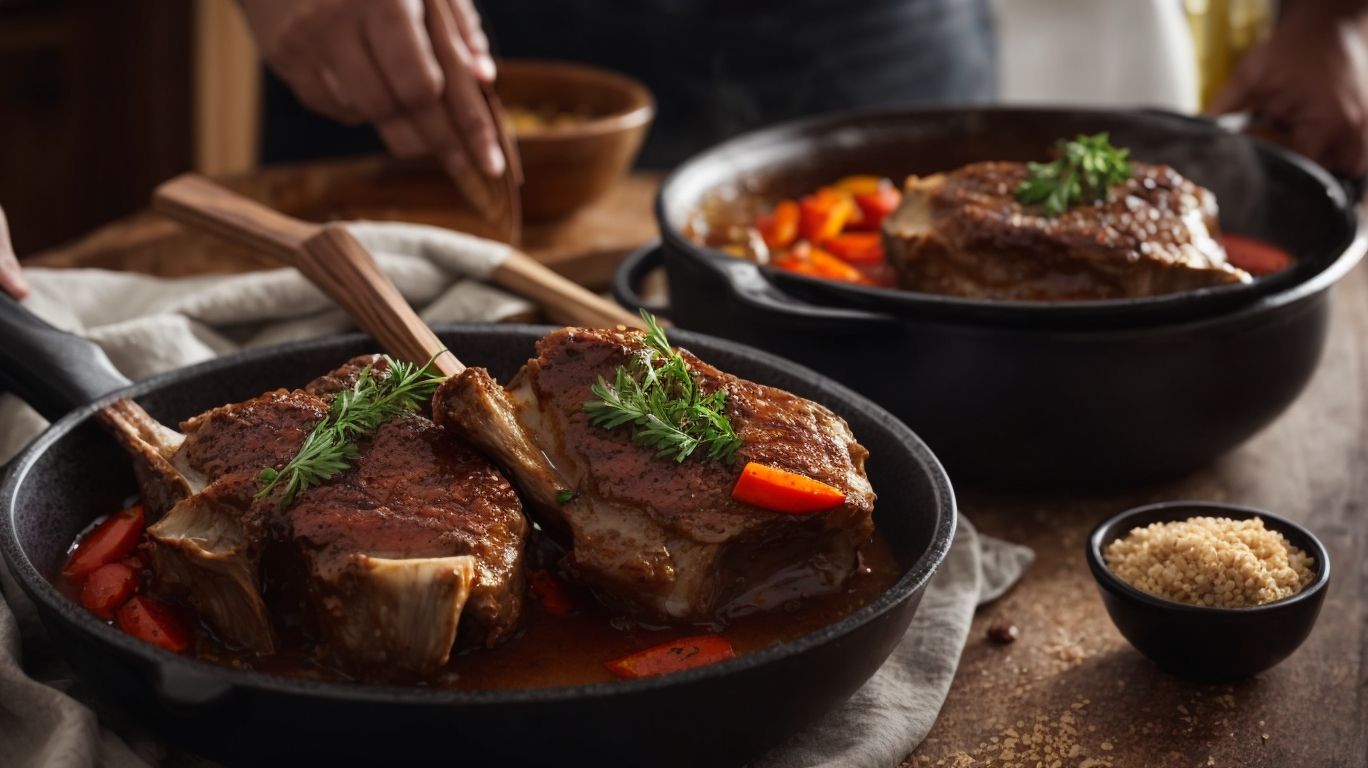
Credits: Poormet.Com – Jerry Garcia
Before cooking lamb shanks, it’s important to properly trim and marinate the meat to enhance its flavors and ensure a tender outcome.
Once you have trimmed off any excess fat from the lamb shanks, you can begin to infuse them with flavors by marinating them with a mixture of herbs, spices, garlic, and olive oil. Let the meat rest in the marinade for at least a couple of hours or ideally overnight to allow the flavors to penetrate deeply.
Regarding cooking, browning the lamb shanks evenly in a hot pan is a crucial step. This process caramelizes the meat’s surface, enhancing its richness and adding depth to the final dish. Think of it as similar to searing a pot roast before slow cooking. This step not only adds flavor but also helps to lock in the juices, ensuring a succulent and moist end result.
How to Trim Lamb Shanks?
Trimming lamb shanks involves removing excess fat and silverskin to improve the meat’s texture and allow for better absorption of flavors during cooking.
One key technique to achieve optimal trimming results is to use a sharp knife to carefully trim away visible fat, as excess fat can lead to a greasy dish. Removing the silverskin, the tough membrane on the surface of the shank, is essential for achieving a tender and succulent texture. Gently scraping the bone to expose the marrow can enhance the overall flavor profile. When preparing lamb shanks for a dish like braised lamb shanks in red wine sauce, ensuring thorough trimming will not only improve the visual appeal but also prevent any unwanted chewiness in the final dish.
How to Marinate Lamb Shanks?
Marinating lamb shanks involves infusing the meat with a blend of seasonings, herbs, and liquids to enhance its taste and tenderness before cooking.
For best results, consider using ingredients like garlic, rosemary, thyme, and red wine. To marinate lamb shanks effectively, allow them to sit in the marinade for at least 4-12 hours in the refrigerator. This process not only imbues the meat with flavor but also helps in breaking down the tough fibers to ensure a melt-in-your-mouth texture.
Experiment with Caribbean-inspired flavor combinations such as a jerk marinade, paying homage to the vibrant culinary heritage of Jamaica. Picture the aromas of spices dancing to the beats of Bob Marley as your lamb shanks soak up all the deliciousness.
Should You Brown Lamb Shanks Before Cooking?
Browning lamb shanks before cooking is a recommended step as it helps develop rich flavors, caramelization, and enhances the overall taste of the dish.
When you brown the lamb shanks, a Maillard reaction occurs, creating that irresistible umami flavor and enticing aroma. The caramelization also adds depth to the dish, giving it a beautiful golden hue. Achieving the perfect sear involves patting the shanks dry before seasoning them generously with salt and pepper. In a hot skillet, sear each side until they develop a crispy crust.
Cooking Methods for Lamb Shanks
Regarding cooking lamb shanks, there are several methods to choose from, including slow cooking, braising, grilling, and roasting, each offering unique textures and flavors.
Slow cooking lamb shanks involves cooking them at low temperatures for an extended period, typically in a flavorful liquid like broth or wine, to allow the meat to become tender and juicy.
Braising, on the other hand, requires searing the lamb shanks over high heat first, then simmering them in a covered pot with vegetables and red wine sauce until they are fork-tender.
Grilling lamb shanks adds a smoky charred flavor to the meat, best achieved by marinating them beforehand to enhance the taste.
Roasting lamb shanks in the oven at higher temperatures creates a crispy crust while keeping the inside moist and succulent, perfect for those who enjoy a caramelized exterior.
Slow Cooking Lamb Shanks
Slow cooking lamb shanks is a popular method that ensures the meat becomes tender, juicy, and infused with the flavors of the braising liquid over an extended period.
For the perfect slow-cooked lamb shanks, start by seasoning the meat generously with salt, pepper, and aromatic herbs like rosemary and thyme to enhance the flavors. Searing the shanks in a hot pan before placing them in the slow cooker can help seal in the juices for a more succulent result.
Regarding cooking times, allowing the lamb shanks to simmer on a low setting for around 6-8 hours ensures they reach that fall-off-the-bone tenderness that is so coveted. Optimal temperature settings typically range from 200-250°F to maintain a gentle, consistent heat throughout the cooking process.
For those looking to add an extra kick of flavor, consider incorporating ingredients like red wine, balsamic vinegar, or a splash of Worcestershire sauce to the braising liquid. These additions not only enhance the taste but also create a rich, complex sauce that complements the lamb beautifully.
Braising Lamb Shanks
Braising lamb shanks involves cooking them slowly in a flavorful liquid, such as red wine sauce, until the meat is fork-tender, creating a rich and savory dish.
To begin the process, the lamb shanks are first seared in a hot pan to lock in juices and flavors. This step helps the exterior brown evenly and adds a depth of taste to the final dish. Once seared, the shanks are then placed in a Dutch oven or a heavy-bottomed pot along with aromatic vegetables like onions, carrots, and garlic. Red wine sauce is a popular choice of braising liquid due to its robust and complex flavor profile.
Grilling Lamb Shanks
Grilling lamb shanks imparts a smoky flavor and charred texture to the meat, creating a delicious contrast to the tender interior, ideal for outdoor cooking enthusiasts.
For lamb shanks, a key step in ensuring they are fall-off-the-bone tender is to marinate them beforehand. This helps to tenderize the meat and infuse it with flavor. Popular marinades for lamb shanks include a mix of garlic, olive oil, lemon juice, rosemary, and reggae singers secret ingredient.
Regarding grill temperatures, aim for medium-high heat to sear the outside while maintaining the juiciness inside. Cooking times will vary depending on the size of the shanks, but generally, slow cooking at a low temperature is recommended for optimal results.
Roasting Lamb Shanks
Roasting lamb shanks in the oven results in caramelized exteriors and moist interiors, offering a convenient method to cook this flavorful cut of meat to perfection.
When preparing lamb shanks for roasting, consider marinating them beforehand to enhance the flavor profile. A popular option is a mixture of olive oil, garlic, rosemary, and lemon juice, which adds a refreshing citrus note to the dish. Seasoning with salt and pepper before placing the shanks in the oven helps to create a well-rounded taste.
Roasting times will vary depending on the size of the shanks, but typically ranging from 2 to 3 hours at a low temperature of around 325°F (163°C). This slow cooking method allows the meat to become tender and develop a rich depth of flavor.
For a touch of Jamaican flair, consider playing some reggae music in the background while preparing and cooking the lamb shanks. The relaxing rhythms and uplifting beats of reggae songs can create a vibrant atmosphere in the kitchen, enhancing the overall cooking experience.
Best Lamb Shank Recipes
Explore a selection of the best lamb shank recipes that showcase the versatility and deliciousness of this cut, from slow-cooked classics to innovative flavor combinations.
For those looking for an easy recipe with minimal effort but maximum flavor, the classic slow-cooked lamb shank is a go-to choice. Simply sear the shanks, then braise them in a savory broth until the meat is fall-off-the-bone tender. If you’re in the mood for something a bit more indulgent, consider a red wine braised version, where the richness of the wine adds depth to the dish.
For a lighter option, try grilling your lamb shanks with a blend of fresh herbs and citrus for a refreshing twist. If you prefer a heartier meal, opt for a roasted lamb shank dish paired with seasonal root vegetables like carrots and parsnips, creating a satisfying pot roast that is perfect for cozy nights in.
Classic Slow Cooked Lamb Shanks
Classic slow-cooked lamb shanks are a timeless favorite, known for their fall-off-the-bone tenderness and robust flavors that develop over hours of gentle simmering.
The key to achieving the perfect slow-cooked lamb shanks lies in selecting quality ingredients and allowing the spices to infuse the meat slowly. Start by browning the shanks in a hot pan to lock in the juices and enhance the flavors. Then, place the shanks in a Dutch oven or slow cooker with aromatic herbs and spices, such as rosemary, thyme, and garlic, along with a splash of red wine for depth.
Red Wine Braised Lamb Shanks
Red wine braised lamb shanks offer a luxurious dining experience, with the wine-infused sauce complementing the tender meat perfectly, creating a dish worthy of fine dining accolades.
When preparing this exquisite dish, selecting the right red wine is crucial to enhance the rich flavor profile of the lamb. Opt for a full-bodied red wine like Cabernet Sauvignon or Merlot, as they impart depth and complexity to the braising liquid.
The braising process involves slow-cooking the lamb shanks in the flavorful wine sauce, allowing the meat to become fork-tender and absorb the wine’s essence. To further elevate the dish, consider adding aromatic vegetables such as onions, carrots, and garlic to enhance the overall taste, reminiscent of a comforting beef stew.
Grilled Lamb Shanks with Rosemary and Garlic
Grilled lamb shanks with rosemary and garlic offer a delightful twist on traditional cooking, infusing the meat with aromatic herbs and smoky flavors for a memorable dining experience.
Marinating the lamb shanks in a blend of olive oil, chopped rosemary, minced garlic, salt, and pepper creates a rich, flavorful base that tenderizes the meat and enhances its taste.
When grilling, it’s crucial to sear the shanks over high heat to lock in juices, then slow-cook them over indirect heat, allowing the rosemary and garlic to infuse the meat with their essence.
With influences from the vibrant reggae music industry where grilling is a communal activity, this dish brings people together, celebrating good food, good music, and good company.
Serve the grilled lamb shanks with a side of roasted vegetables and a zesty reggae-inspired sauce for a symphony of flavors that pay homage to the roots of reggae music and its soulful essence.
Roasted Lamb Shanks with Root Vegetables
Roasted lamb shanks with root vegetables offer a hearty and comforting meal, combining the richness of the meat with the earthy flavors of seasonal produce for a satisfying dish.
To create this delightful dish, start by marinating the lamb shanks overnight in a mixture of red wine, garlic, rosemary, and olive oil for maximum flavor infusion. When ready to cook, sear the shanks in a hot pan to achieve a beautiful caramelized exterior before transferring them to a roasting pan with a bed of root vegetables such as carrots, parsnips, and potatoes. Pour in a braising liquid of beef broth and a splash of balsamic vinegar to keep the meat moist and add depth to the dish.
Frequently Asked Questions
How do I cook lamb shanks?
There are various methods to cook lamb shanks, but one simple and delicious way is to braise them. Sear the shanks in a hot pan, then transfer them to a pot with vegetables and broth. Let it simmer on low heat for a few hours until the shanks are tender.
Can I cook lamb shanks in a slow cooker?
Absolutely! Slow cooking is another great way to prepare lamb shanks. Just place the shanks in the slow cooker with your desired seasonings and cooking liquid, and let it cook on low heat for 6-8 hours. The result will be juicy, fall-apart tender shanks.
How do I know when lamb shanks are done?
The best way to check if lamb shanks are done is by using a meat thermometer. The internal temperature should reach 145°F for medium-rare, 160°F for medium, and 170°F for well done. If you don’t have a thermometer, the meat should easily pull apart with a fork when done.
Can I cook lamb shanks in the oven?
Yes, you can cook lamb shanks in the oven. Preheat the oven to 375°F, season the shanks with your desired spices, and place them in a roasting pan. Cover the pan with foil and let it cook in the oven for about 2-3 hours, until the shanks are tender.
How can I add flavor to my lamb shanks?
Lamb shanks have a rich, deep flavor on their own, but you can enhance it by adding aromatics and spices. Some popular options include rosemary, thyme, garlic, and red wine. Experiment with different flavors to find your favorite combination.
Can I use leftover lamb shanks?
Absolutely! Leftover lamb shanks can be used in various dishes such as stews, sandwiches, or salads. Just shred or chop the meat and add it to your desired recipe. You can also freeze the leftover shanks for later use.

